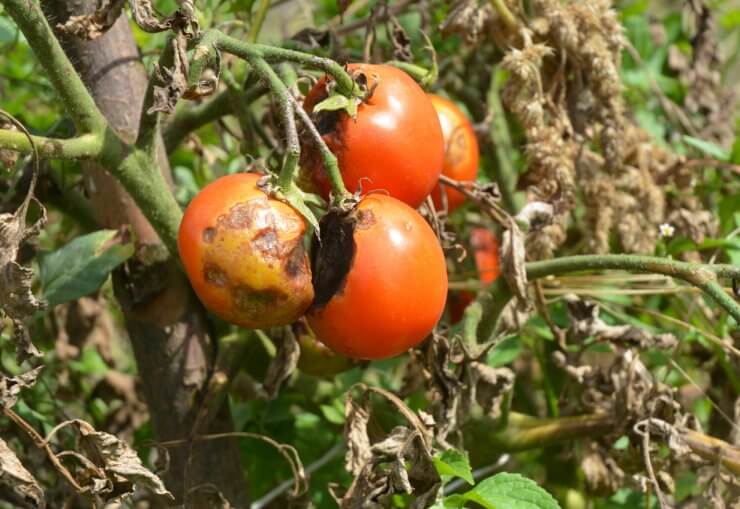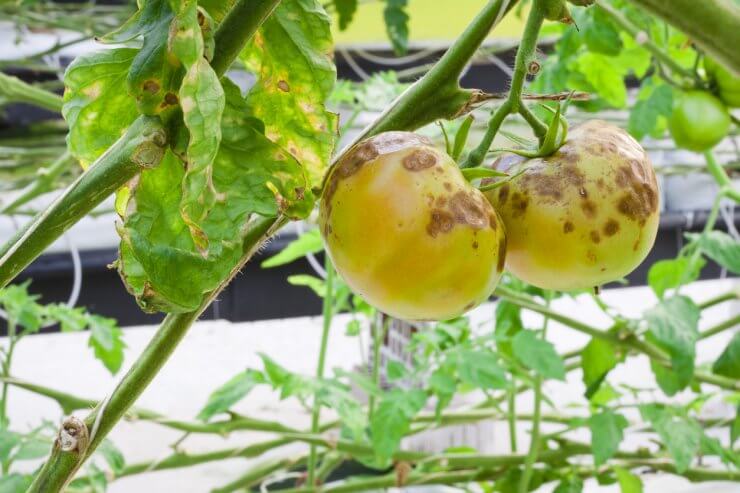
I don’t like to write about vegetable blight. Usually, when someone starts asking about it, it’s already too late. That’s especially true in smaller gardens where you may only have a few tomato plants, which could be infected before you realize it.
Fortunately, there’s more than one kind of blight. I know that sounds strange. You’re undoubtedly wondering what’s gotten into my head that I’m happy that there are multiple types of blight. The thing is, vegetable blight, like Sharknado movies, can be either bad but bearable or absolutely terrible. Let me explain.
Discover 7 top tips for growing, harvesting, and enjoying tomatoes from your home garden—when you access the FREE guide The Best Way to Grow Tomatoes, right now!

What is Vegetable Blight?
There are three different types of blight that may infect your tomatoes. One of the most common is early blight. Early blight won’t necessarily ruin your vegetables, but it will significantly limit production. Early blight starts as small brown or black lesions, often developing the appearance of a target or bull’s eye. The most frequent result of early blight is the loss of foliage.
Another common problem is septoria leaf spot. This vegetable blight primarily infects foliage, starting with circular lesions on the lower leaves. Leaf spot can spread rapidly and destroy foliage, but does not usually affect the fruit.
The most severe type of vegetable blight is late blight. Late blight (Phytophthora infestans) can spread rapidly and obliterate tomatoes and potatoes in a matter of days. Late blight was the pathogen responsible for the Irish potato famine in the 1840s.
The University of Massachusetts Extension Vegetable Program describes the tell-tale symptoms as “large (at least nickel-sized) olive-green to brown spots on leaves with slightly fuzzy white fungal growth on the underside when conditions have been humid (early morning or after rain). Sometimes the lesion border is yellow or has a water-soaked appearance. Brown to blackish lesions also develop on upper stems. Firm, brown spots develop on tomato fruit.”
If your tomatoes (or potatoes) are carrying late blight, the only thing you can do is destroy them, as well as a perimeter of healthy plants around them.
Prevention is the Best Medicine
The best way to stop vegetable blight from ruining your tomatoes is to prevent it. Here are five things you can do to help stop blight before it starts.
Water the soil, not the plant. Dry leaves are not great environments for fungal spores. Additionally, any spores in the soil can splash up onto plant leaves when you water from above.
Use mulch. Again, affected soil can splash onto plant leaves or get carried by birds or other critters. Mulch creates a barrier that can prevent the transfer of infected soil.
Plant-resistant varieties. Though there is no complete immunity from vegetable blight, resistant varieties are less likely to become infected.
Use tomato cages. These help prevent leaves from lying on the ground and improve air circulation, so there’s nowhere for blight spores to hide.
Buy disease-free seeds and seedlings. This seems obvious enough, but we’ve all been guilty of missing the obvious.
Bonus Tip: I’m adding this as a bonus because I can’t vouch for it, but some sources suggest baking soda is an excellent natural fungicide to use for blight. Just mix a teaspoon of baking soda with a quart of water and a couple of drops of dish soap. Hey, if baking soda can make my buttermilk biscuits rise, clean my toilet, deodorize my refrigerator, and clear a clogged drain, who am I to doubt that it could take care of vegetable blight?
Want to Grow Healthy Tomatoes?
In our Tomato Collection, we give you everything you need to know about growing and enjoying this versatile food. From the history and background of the mighty tomato to specific advice about soil requirements and fertilizer … from watering techniques to details about avoiding tomato rot … from easy-to-make and delicious recipes that will allow you to enjoy the fruits of your gardening labor to the nutritional benefits of tomatoes—get it all in our Tomato Collection right now!
Have you had to deal with tomato blight? What steps did you take to solve the issue?
Discover 7 top tips for growing, harvesting, and enjoying tomatoes from your home garden—when you access the FREE guide The Best Way to Grow Tomatoes, right now!





I am interested in more information about your bonus tip. What do I do with the baking soda solution, spray it on the leaves tops and bottoms, on the fruits and soil?
Sorry, yes, a light spray all over the whole plant can stop the spread of blight. Do it at night, or after the sun has gone down.